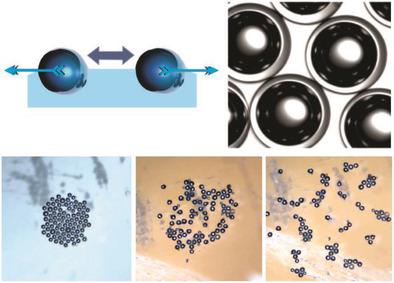当前位置:
X-MOL 学术
›
Adv. Mater. Interfaces
›
论文详情
Our official English website, www.x-mol.net, welcomes your
feedback! (Note: you will need to create a separate account there.)
Nanoparticle‐Shelled Catalytic Bubble Micromotor
Advanced Materials Interfaces ( IF 4.3 ) Pub Date : 2020-01-14 , DOI: 10.1002/admi.201901583 Laura L. A. Adams 1, 2 , Daeyeon Lee 3 , Yongfeng Mei 4 , David A. Weitz 1 , Alexander A. Solovev 1, 4
Advanced Materials Interfaces ( IF 4.3 ) Pub Date : 2020-01-14 , DOI: 10.1002/admi.201901583 Laura L. A. Adams 1, 2 , Daeyeon Lee 3 , Yongfeng Mei 4 , David A. Weitz 1 , Alexander A. Solovev 1, 4
Affiliation

|
Nanoparticle‐shelled bubbles, prepared with glass capillary microfluidics, are functionalized to produce catalytic micromotors that exhibit novel assembly and disassembly behaviors. Stable microbubble rafts are assembled at an air–solvent interface of nonaqueous propylene carbonate (PC) solvent by creating a meniscus using a glass capillary. Upon the addition of hydrogen peroxide fuel, catalytic microbubbles quickly break free from the bubble raft by repelling from each other and self‐propelling at the air–fuel interface (a mixture of PC and aqueous hydrogen peroxide). While most of micromotors generate oxygen bubbles on the outer catalytic shell, some micromotors contain cracks and eject bubbles from the hollow shells containing air. Nanoparticle‐shelled bubbles with a high buoyancy force are particularly attractive for studying novel propulsion modes and interactions between catalytic bubble micromotors at air–fuel interfaces.
中文翻译:

纳米壳催化气泡微电机
用玻璃毛细管微流体制备的带壳纳米气泡,经过功能化后可生产出具有新颖组装和拆卸性能的催化微电机。通过使用玻璃毛细管产生弯月面,可以在非水碳酸亚丙酯(PC)溶剂的空气-溶剂界面处组装稳定的微泡筏。添加过氧化氢燃料后,催化微气泡会彼此排斥并在空气-燃料界面(PC和过氧化氢水溶液的混合物)中自我推进,从而迅速脱离气泡筏。尽管大多数微型电动机在催化外壳上会产生氧气气泡,但有些微型电动机会产生裂纹,并从装有空气的中空壳中喷射出气泡。
更新日期:2020-01-14
中文翻译:

纳米壳催化气泡微电机
用玻璃毛细管微流体制备的带壳纳米气泡,经过功能化后可生产出具有新颖组装和拆卸性能的催化微电机。通过使用玻璃毛细管产生弯月面,可以在非水碳酸亚丙酯(PC)溶剂的空气-溶剂界面处组装稳定的微泡筏。添加过氧化氢燃料后,催化微气泡会彼此排斥并在空气-燃料界面(PC和过氧化氢水溶液的混合物)中自我推进,从而迅速脱离气泡筏。尽管大多数微型电动机在催化外壳上会产生氧气气泡,但有些微型电动机会产生裂纹,并从装有空气的中空壳中喷射出气泡。











































 京公网安备 11010802027423号
京公网安备 11010802027423号